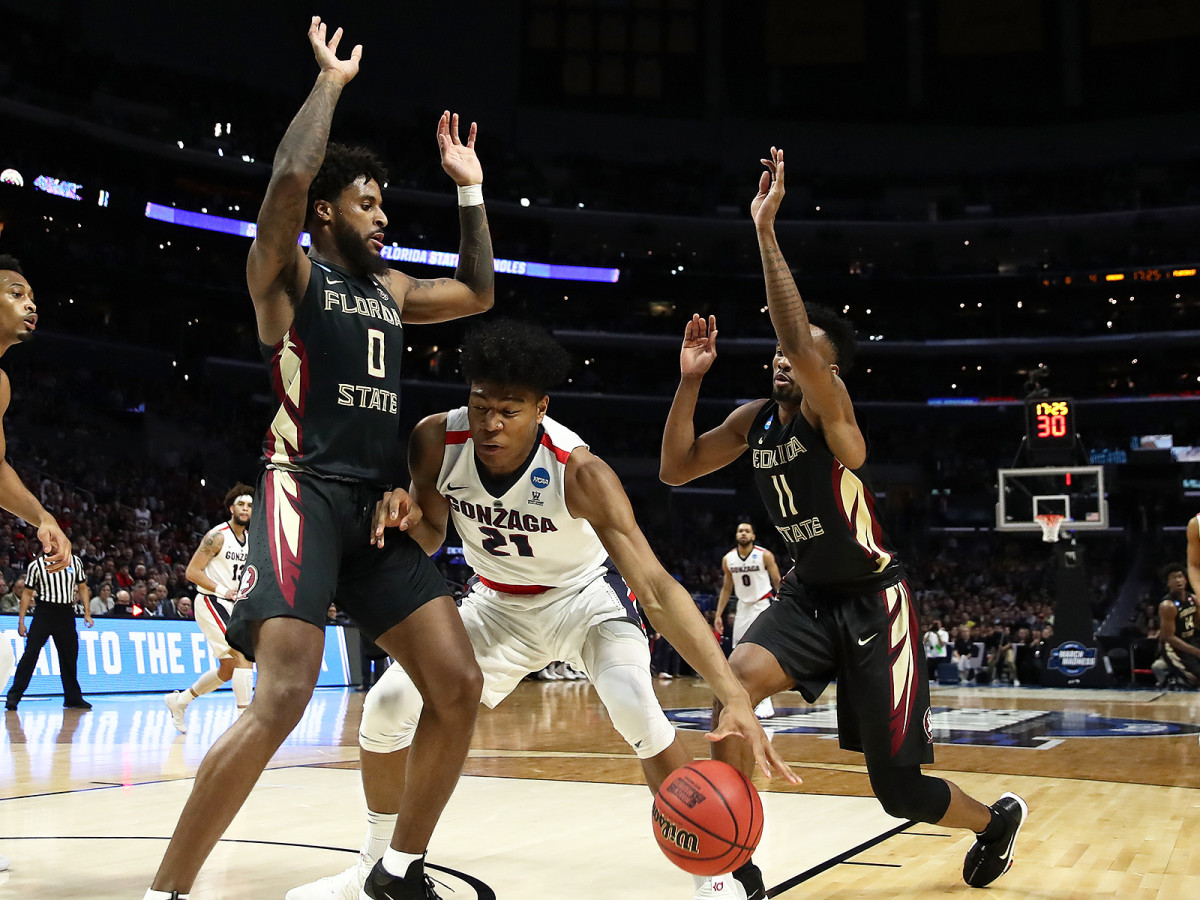Florida State Continues Theme of the Tournament, Knocks Off Gonzaga to Reach Elite Eight

LOS ANGELES — As the final seconds ticked off the spaceship-sized scoreboard at the Staples Center, Florida State’s bench engaged in a muted celebration. One player waved a white towel, while another grabbed one for a keepsake. There were smiles and bro hugs and even some awkward skipping, but it also seemed like the Seminoles were not surprised by their best NCAA tournament in 25 years.
Perhaps they were alone in expecting the unexpected. This wasn’t a football game but a basketball contest and Florida State’s hardwood representatives had entered this season with a depleted roster, suffered injuries to key players, lost 11 games and then … beaten a No. 1 seed in this tournament and toppled last year’s runner-up. The No. 1 seed was Xavier, which Florida State defeated last week to reach the Sweet 16 in the West Region.
What happened next was just as unexpected. The Seminoles took the court on Thursday night against Gonzaga, a team making its 20th-straight NCAA tournament appearance, the year after it lost to North Carolina in the final. The Zags had an emerging star in guard Zach Norvell Jr., a dependable big-man in forward Johnathan Williams and their latest sharpshooter in forward Killian Tillie. Only Tillie didn’t play, after suffering a hip pointer in Tuesday’s practice, and Williams found himself again in foul trouble and Florida State bottled Norvell and the rest of the Zags in a 75–60 triumph, which was as lopsided as the score indicated.
Third Straight Clutch Shot, Third Straight Upset for Elite Eight-Bound Cinderella Loyola-Chicago
The victory catapulted Florida State back into the Elite Eight for the first time since the 1992–93 season. Should the Seminoles win here again on Saturday, they’ll advance to the Final Four for the first time since 1971–72 and the first time under coach Leonard Hamilton, who took over the program in 2002–03 and has remained there through solid if unspectacular results.
His counterpart on Thursday, Gonzaga coach Mark Few, saw on film what played on Thursday night. He said that as he studied FSU he got a bad feeling in his stomach. Florida State was long and athletic and aggressive, especially on defense. Asked afterward to compare the Seminoles to another team they had played this season and Gonzaga’s players could not remember an immediate comparison. “They were long,” guard Silas Melson said.

The Seminoles simply shot better than the Bulldogs. The Zags made 33.9% of their shots and only five of their 20 three-point attempts. Florida State, meanwhile, forced Norvell into a 4-of-16 performance, held Williams to eight points and generally frustrated the Zags into bad shots.
That was evident at halftime, when FSU led, 41–32, and its advantage seemed potentially like a prelude to a Gonzaga comeback. It never came. Afterward, the Seminoles players said they wanted to speed the Bulldogs up, force them to run and take shots quickly and score fast. That never happened. Well, it happened. Just for Florida State.
The Seminoles showed their balance on the stat sheet. Junior guard Terance Mann was the only FSU player who reached double figures in scoring, with 18. Six other Seminoles scored at least six points. “We have to win games by committee,” Hamilton said. “That has been our philosophy for a number of years.”

Afterward, Hamilton said he told his team to stay focused, to continue to follow the routine that had enabled them to win another game and advance to the Elite Eight. He told them to remember they played in the ACC and had to play against teams with Gonzaga’s pedigree every night. That had steeled them.
The Seminoles' run only cemented the improbability at play here in this NCAA tournament. March may be known for its annual madness but this year feels particularly pronounced. It’s all nuns and dogs and the first No. 16 seed to topple a No. 1 in the men’s bracket.
FSU provided additional proof. The Seminoles lost their top three scorers from last season, hadn’t advanced into the second week of the tournament since 2011–12 and finished .500 in conference play. They weren’t even a lock to get a berth, having lost three of their final four games, including to Louisville in their first game in the ACC tournament.
Michigan Asserts Itself as a Final Four Contender in Rout of Texas A&M
At the start of its season, Florida State had only two seniors and three players who had been on the roster for more than two seasons. Center Christ Koumadje missed 11 games to injury. Guard P.J. Savoy missed eight. Even Mann, the Seminoles leading scorer and rebounder, was questionable with a groin injury for FSU’s tournament opener against Missouri. He did play, but scored only two points, while the bench led Florida State to victory, scoring 42 of the team’s 67 points.
“Depth is nice,” Few said.
By knocking off Xavier and Gonzaga, Florida State by itself helped open up the left side of the NCAA tournament. Michigan, the Seminoles opponent here on Saturday, is the highest seed remaining, a three.
Florida State, with its length, its athleticism and its confidence, now thinks that it can make it to San Antonio. Maybe even win it. The way this tournament has gone, that seemed more possible on Thursday at the Staples Center than it ever had before.
